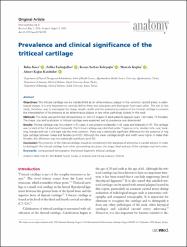| dc.contributor.author | Koca, Rabia | |
| dc.contributor.author | Fazlıoğulları, Zeliha | |
| dc.contributor.author | Keleşoğlu, Kazım Serhan | |
| dc.contributor.author | Koplay, Mustafa | |
| dc.contributor.author | Karabulut, Ahmet Kağan | |
| dc.date.accessioned | 2022-07-01T09:22:28Z | |
| dc.date.available | 2022-07-01T09:22:28Z | |
| dc.date.issued | 2020 | en_US |
| dc.identifier.citation | Rabia, K. O. C. A., FAZLIOĞULLARI, Z., KELESOGLU, K., Koplay, M., & Karabulut, A. K. (2020). Prevalence and clinical significance of the triticeal cartilage. Anatomy, 14(2), 97-101. | en_US |
| dc.identifier.issn | 1308-8459 | |
| dc.identifier.uri | https://doi.org/10.2399/ana.20.762981 | |
| dc.identifier.uri | https://hdl.handle.net/20.500.12933/1286 | |
| dc.description.abstract | Objectives: The triticeal cartilage can be misidentified as an atheromatous plaque in the common carotid artery in radiological images. It is very important to correctly define these two structures and distinguish from each other. The aim of this
study, therefore, was to investigate the shape, length, width and the anatomical position of the triticeal cartilage to prevent
the interpretation of its presence as an atheromaous plaque or any other pathology located in the neck.
Methods: This study was performed retrospectively on 200 CT images of adult patients (age≥20 years; 128 males, 72 females).
The shape, size and localization of triticeal cartilage were examined and its prevalence was determined.
Results: Triticeal cartilage was not present in 63 cases. It was present unilaterally in 42 cases and bilaterally in 95. The cartilage
was located at the C4 level most frequently. The triticeal cartilage was identified under 7 types as circle, double circle, oval, hook,
ring, triangle and rod. Circle type was the most common. There was a statistically significant difference for the presence of ring
type cartilage between males and females (p<0.05). Although the mean cartilage length and width were higher in males than
females, this difference was not statistically significant (p>0.05).
Conclusion: The presence of the triticeal cartilage should be considered in the diagnosis of atheroma in carotid arteries. In order
to distinguish the triticeal cartilage from other surrounding structures, the shape, level and size of the cartilage must be known. | en_US |
| dc.language.iso | eng | en_US |
| dc.publisher | Turkish Society of Anatomy and Clinical Anatomy (TSACA) | en_US |
| dc.relation.isversionof | 10.2399/ana.20.762981 | en_US |
| dc.rights | info:eu-repo/semantics/openAccess | en_US |
| dc.subject | Computerized tomography | en_US |
| dc.subject | Thyrohyoid ligament | en_US |
| dc.subject | Triticeal cartilage | en_US |
| dc.title | Prevalence and clinical significance of the triticeal cartilage | en_US |
| dc.type | article | en_US |
| dc.authorid | 0000-0002-9052-3002 | en_US |
| dc.department | AFSÜ, Sağlık Bilimleri Fakültesi, Fizyoterapi ve Rehabilitasyon Bölümü | en_US |
| dc.contributor.institutionauthor | Koca, Rabia | |
| dc.identifier.volume | 14 | en_US |
| dc.identifier.issue | 2 | en_US |
| dc.identifier.startpage | 97 | en_US |
| dc.identifier.endpage | 101 | en_US |
| dc.relation.journal | Anatomy | en_US |
| dc.relation.publicationcategory | Makale - Uluslararası Hakemli Dergi - Kurum Öğretim Elemanı | en_US |
















